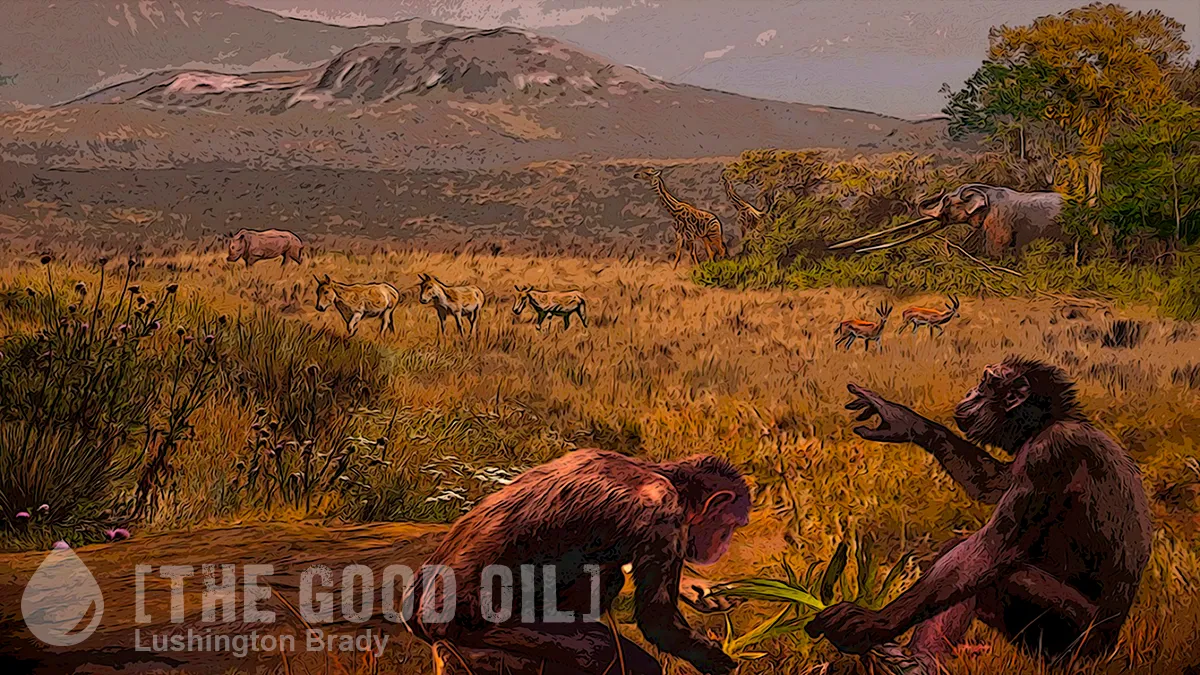A pair of new papers are challenging one of the most sacred cows of human evolution: the ‘Out of Africa’ theory. To be sure, the arguments made in the papers are a bit of a reach, but the fury of the counterattacks give away just what a politically sensitive topic it really is.
So, what’s the heresy?
The common lineage of great apes and humans split several hundred thousand earlier than hitherto assumed, according to an international research team headed by Professor Madelaine Böhme from the Senckenberg Centre for Human Evolution and Palaeoenvironment at the University of Tübingen and Professor Nikolai Spassov from the Bulgarian Academy of Sciences.
The researchers investigated two fossils of Graecopithecus freybergi with state-of-the-art methods and came to the conclusion that they belong to pre-humans.
OK, so what? Here’s the kicker:
Their findings, published today in two papers in the journal PLOS ONE, further indicate that the split of the human lineage occurred in the Eastern Mediterranean and not – as customarily assumed – in Africa.
Present-day chimpanzees are humans’ nearest living relatives. Where the last chimp-human common ancestor lived is a central and highly debated issue in palaeoanthropology. Researchers have assumed up to now that the lineages diverged five to seven million years ago and that the first pre-humans developed in Africa.
What was merely an interesting theory, though, has become overloaded with cultural baggage. After all, this is the same ‘science’ which improbably claims that early Britons like Cheddar Man were ‘black’, on the basis of… well, no real evidence at all. Just, like a British copper stumbling across a Pakistani raping an underage white girl, the scientists openly stated that they didn’t want to ‘seem racist’.
According to the 1994 theory of French palaeoanthropologist Yves Coppens, climate change in Eastern Africa could have played a crucial role. The two studies of the research team from Germany, Bulgaria, Greece, Canada, France and Australia now outline a new scenario for the beginning of human history.
The team analysed two specimens of Graecopithecus freybergi, a lower jaw and an upper premolar. They conclude that the teeth are more characteristic of pre-human lineage than great apes.
“We were surprised by our results, as pre-humans were previously known only from sub-Saharan Africa,” said Jochen Fuss, a Tübingen PhD student who conducted this part of the study.
Furthermore, Graecopithecus is several hundred thousand years older than the oldest potential pre-human from Africa, the six to seven million-year-old Sahelanthropus from Chad […]
Professor David Begun, a University of Toronto paleoanthropologist and co-author of this study added, “This dating allows us to move the human-chimpanzee split into the Mediterranean area.”
Still, as critics point out, minor dental features are a fairly provisional means of making such a radical scientific claim.
A claim that, moreover, threatens to upset the apple cart of the Great Awokening. So what should merely be a mildly interesting new theory of human origins suddenly becomes political dynamite.
Contrary to what we see today, Pliocene Southern Europe featured a savannah biome. More importantly, the Mediterranean basin was at this time a wide rift valley, with the Atlantic entrance blocked.
Using a combination of new methodologies, they studied microscopic fragments of charcoal and plant silicate particles, called phytoliths. Many of the phytoliths identified derive from grasses and particularly from those that use the metabolic pathway of C4-photosynthesis, which is common in today’s tropical grasslands and savannahs. The global spread of C4-grasses began eight million years ago on the Indian subcontinent – their presence in Europe was previously unknown.
“The phytolith record provides evidence of severe droughts, and the charcoal analysis indicates recurring vegetation fires,” said Böhme. “In summary, we reconstruct a savannah, which fits with the giraffes, gazelles, antelopes, and rhinoceroses that were found together with Graecopithecus,” Spassov added.
“The incipient formation of a desert in North Africa more than seven million years ago and the spread of savannahs in Southern Europe may have played a central role in the splitting of the human and chimpanzee lineages,” said Böhme. She calls this hypothesis the North Side Story, recalling the thesis of Yves Coppens, known as East Side Story.
We probably won’t be rewriting the textbooks just yet. Although, if nothing else, it’s highly amusing to contemplate the rivers of salty tears if it is established that humanity originated in Europe after all.









